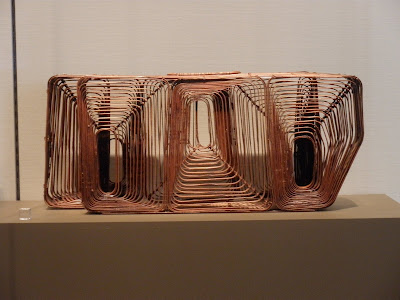The Other Side of the Samurai

This is a hand crafted Japanese basket. It's not from the Samurai exhibit, because you're not allowed to take photos of the Samurai Exhibit at the Asian Art Museum, even if you are The Great Plotnik and are getting your own private tour. Plotnik's friend and ex-neighbor, Lois, is a docent at the museum and Asian art is her world now. So Plotnik got to see this extraordinary exhibit alongside his own walking, talking, well-informed sidekick. What he saw is nothing less than several of the most beautiful -- well, anythings -- that he has ever seen.
There is this one long screen, on which is painted -- trees. A few huts. A few people. That's it. Man! You should see those trees. Sorry, no pictures.
Japanese art is probably what interested Plotnik in studying the Japanese language in the first place, when he and Ducknik first arrived in Saint Plotniko. The idea of a culture as bellicose as the Japanese, on one hand, and so devoted to artistic expression, on the other; or to put it more simply, a people so tight-assed outwardly but inwardly so longing for elusive beauty, fascinated him then and still fascinates him now.
The Samurai were simply knights in shining armor -- not much different than their counterparts in Europe, except it all happened a few hundred years later. Their purpose was to defend the Shogun's land. So they built castles surrounded by moats and defended them to the end. Nothing new here.
What's different is the devotion they put into their art and the art they put into their everyday lives.
Take the famous Japanese Raku Pottery. The Shogun (from the same family who, 18 generations later, sent its patriarch to Saint Plotniko to officially open the Samurai Exhibit a few months ago -- the exhibition is composed of art which has all been borrowed from the Hosegawa family's personal archives) decided he needed new bowls for drinking tea. He admired a certain ornamented roof tile, which, it turned out, was crafted by a Korean tile maker. So the Shogun sent his Samurai on a mission to invade Korea in order to go to the village where the Korean tile maker's family still lived, kidnap them all and bring them back to Kyoto.
Once that was accomplished, the Shogun gave the family a place of honor, built them a palace next to the best clay beds in Japan, and put them to work. He told them to go make tea bowls, but not just tea bowls, the best, most glorious tea bowls anyone had ever seen. And not only that -- he wanted something completely new, no Chinese influences, no Emperor's court stuff. Brand new art so he could drink his tea more pristinely. Roof tiles: tea bowls.
And you better not screw up. They didn't.
He gave the family a new, honored name: Raku. Today, Raku Pottery is still considered among the finest in the world, and is still being made by the 15th generation of potters whose family was originally kidnapped from Korea because they made really swinging roof tiles.
A lot of people had to die to get those potters to Japan. That's the other side of the Samurai.

Ah, but their demented language. It's like their castles. Do you know that Samurai castles were all mazes? If you managed to get across the moat and over the sloping walls and past the archers you ended up on a street that went nowhere.
The Japanese language goes nowhere. You listen and you listen and you wait to see what the HELL is the point of what the speaker is saying, but the verb doesn't come until the very, very end and by then you've forgotten all the rest.
We say: Hello. You are very welcome. Come on in.
They say: Hello: Honored person of great exalted station, to my poor unworthy dogs piss on the walls castle of no value whatsoever I should myself stab in the left eye having invited person so noble so wise so perfect to waste valuable seconds breathing wife barf in the kitchen food so inedible smells, wasting your time you are, but in come. I guess.
Like I say, a maze. The Emperor isn't home anyway, he's painting the perfect peony.


4 Comments:
Is that Lois in that second picture? Either she is very eccentric and you snuck that picture or she let you take at least that one picture. As peculiar as we find the Japanese culture, they must find ours a total train wreck. Although a train wreck that buys so many cars can be useful.
Oh, I bet you had a great time with Lois! We enjoyed the exhibit too.
Came across another site that explores the darker side of samurai, with considerable humor but also a lot of depth:
www.asiansart.org/samurai1.html
Thanks, Anonymous, that was a really cool link. But so the Samurai chopped off 38,000 noses and buried them in a pit. That takes up less room than arms or torsos, doesn't it? Or did they bury not the noses, but the nose-less people? That would change my perceptions.
Post a Comment
<< Home